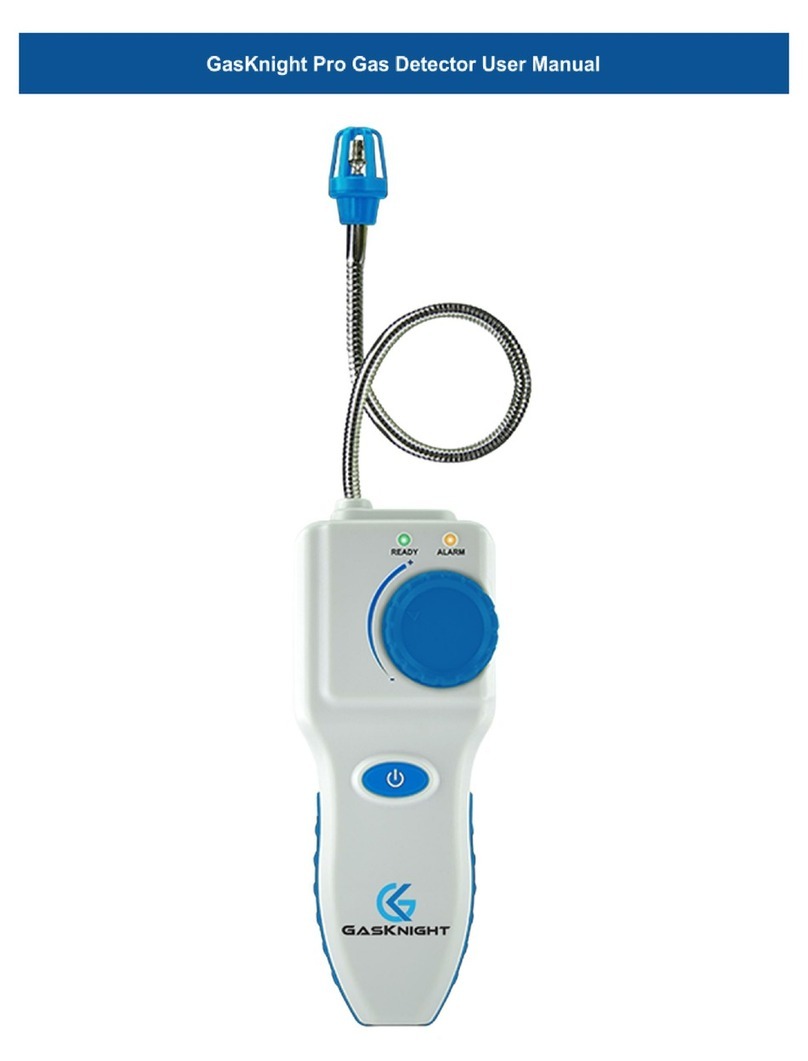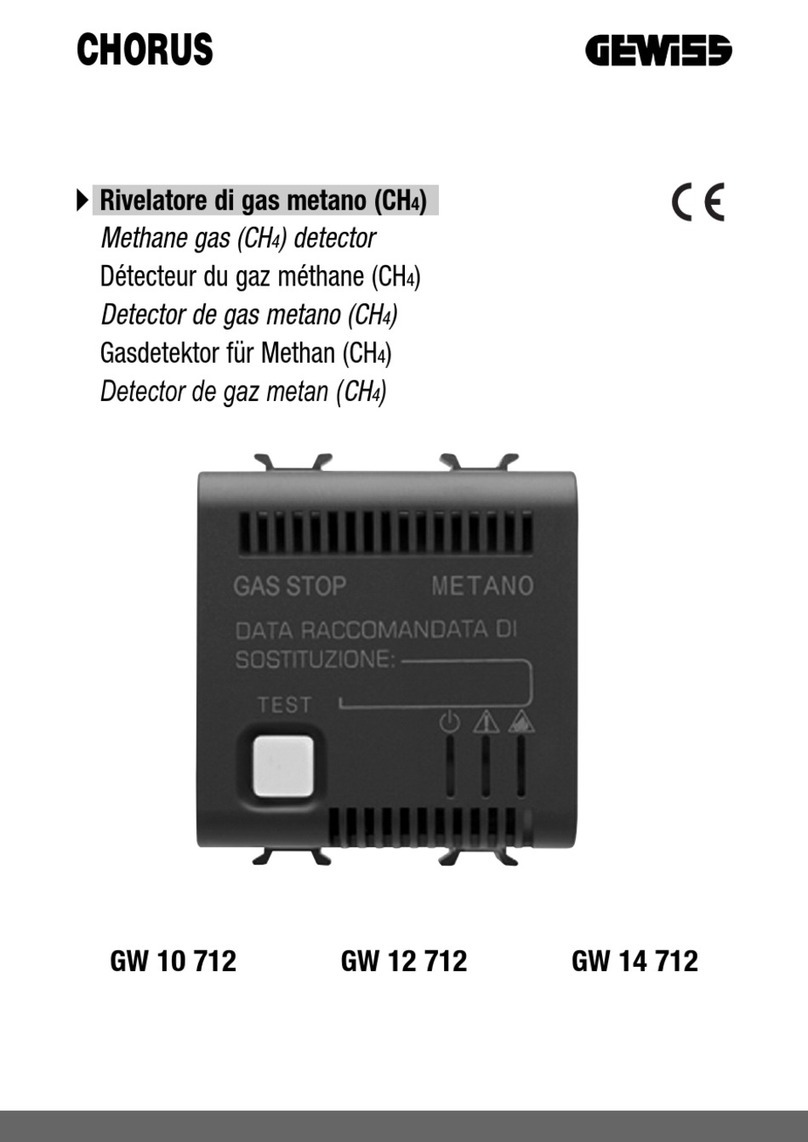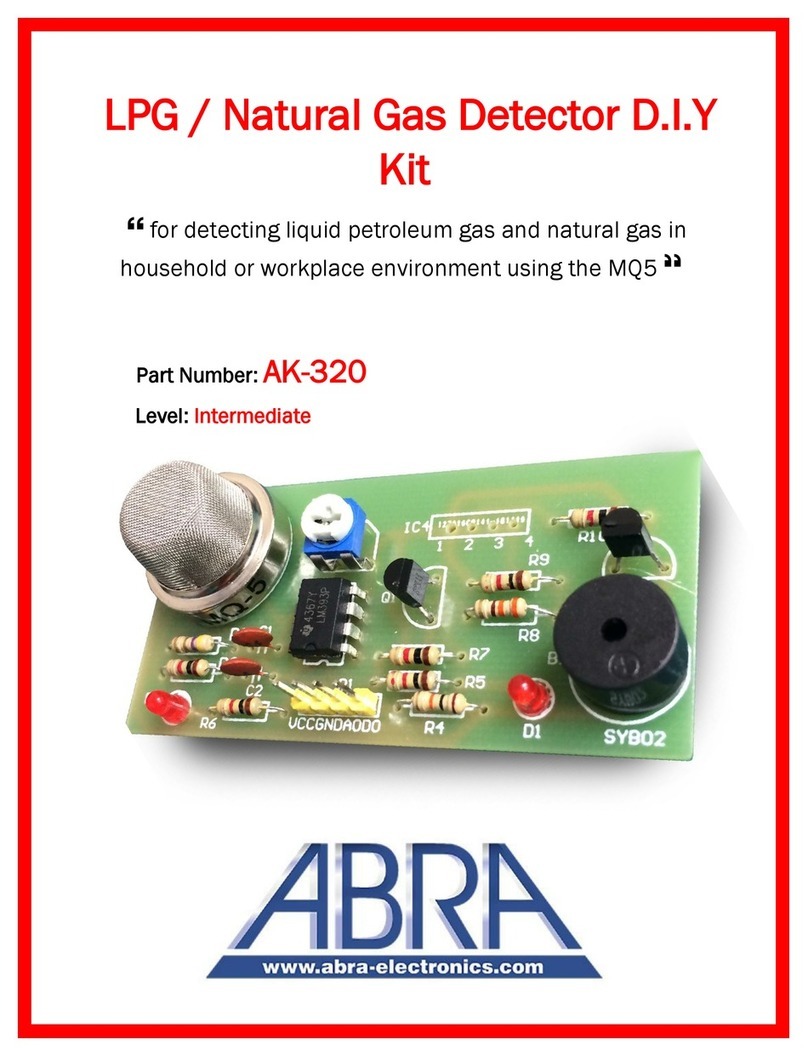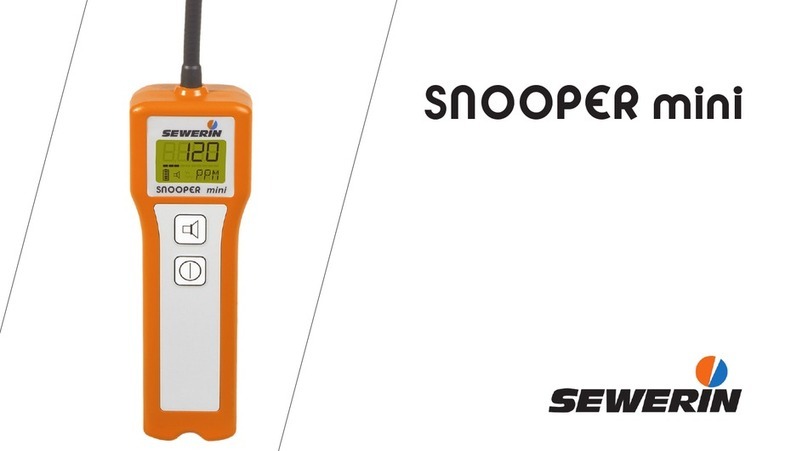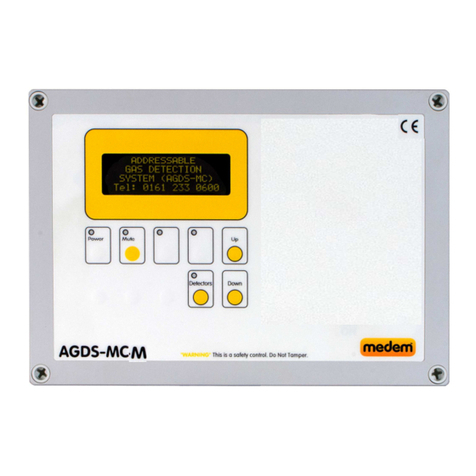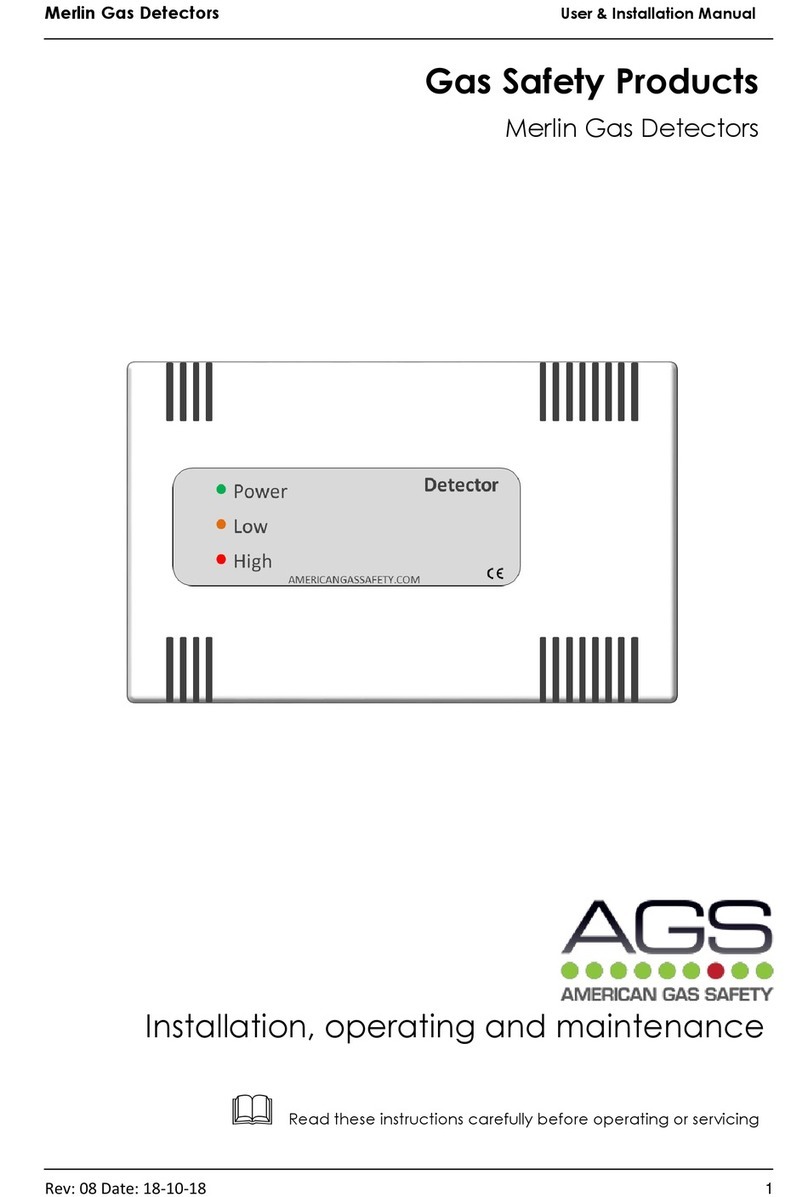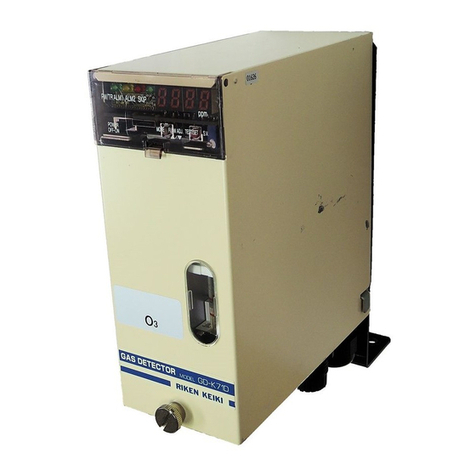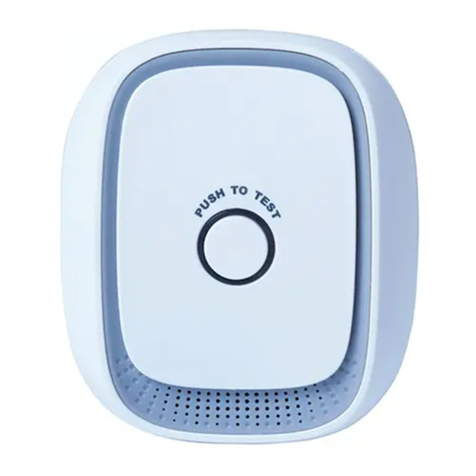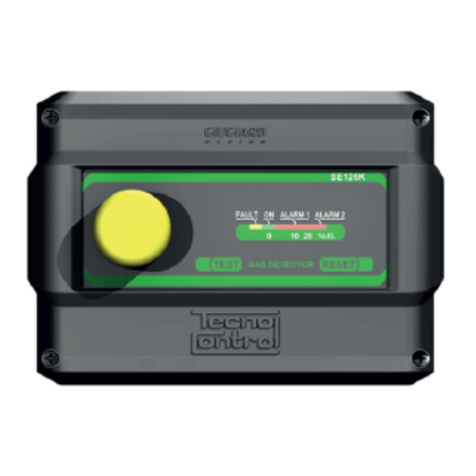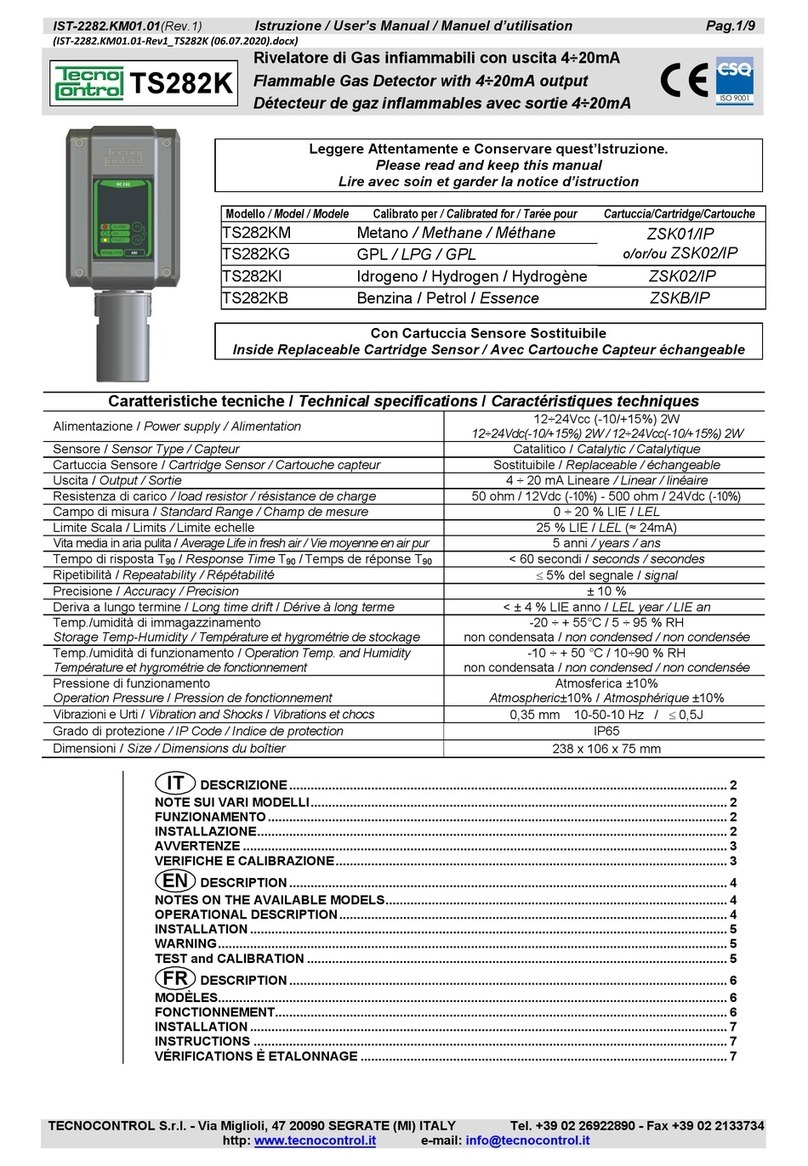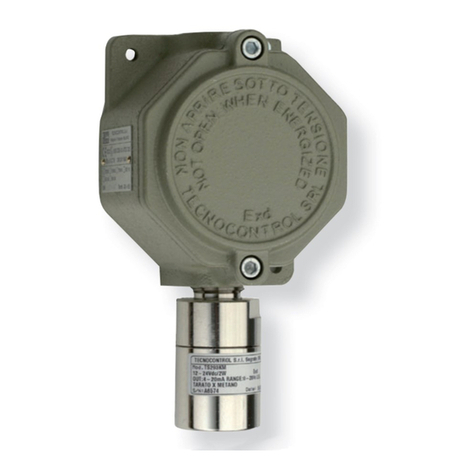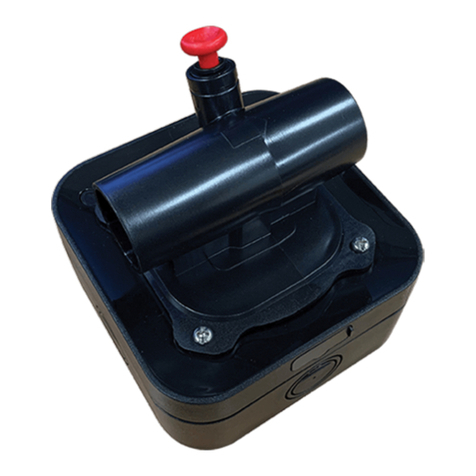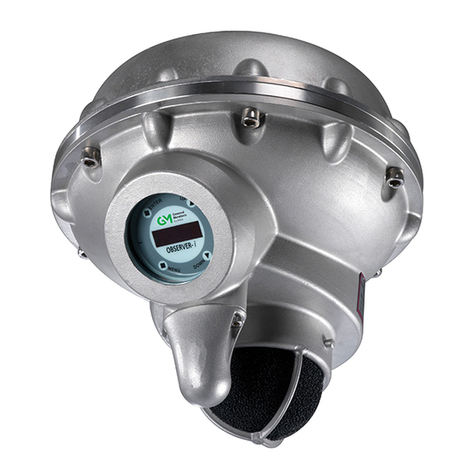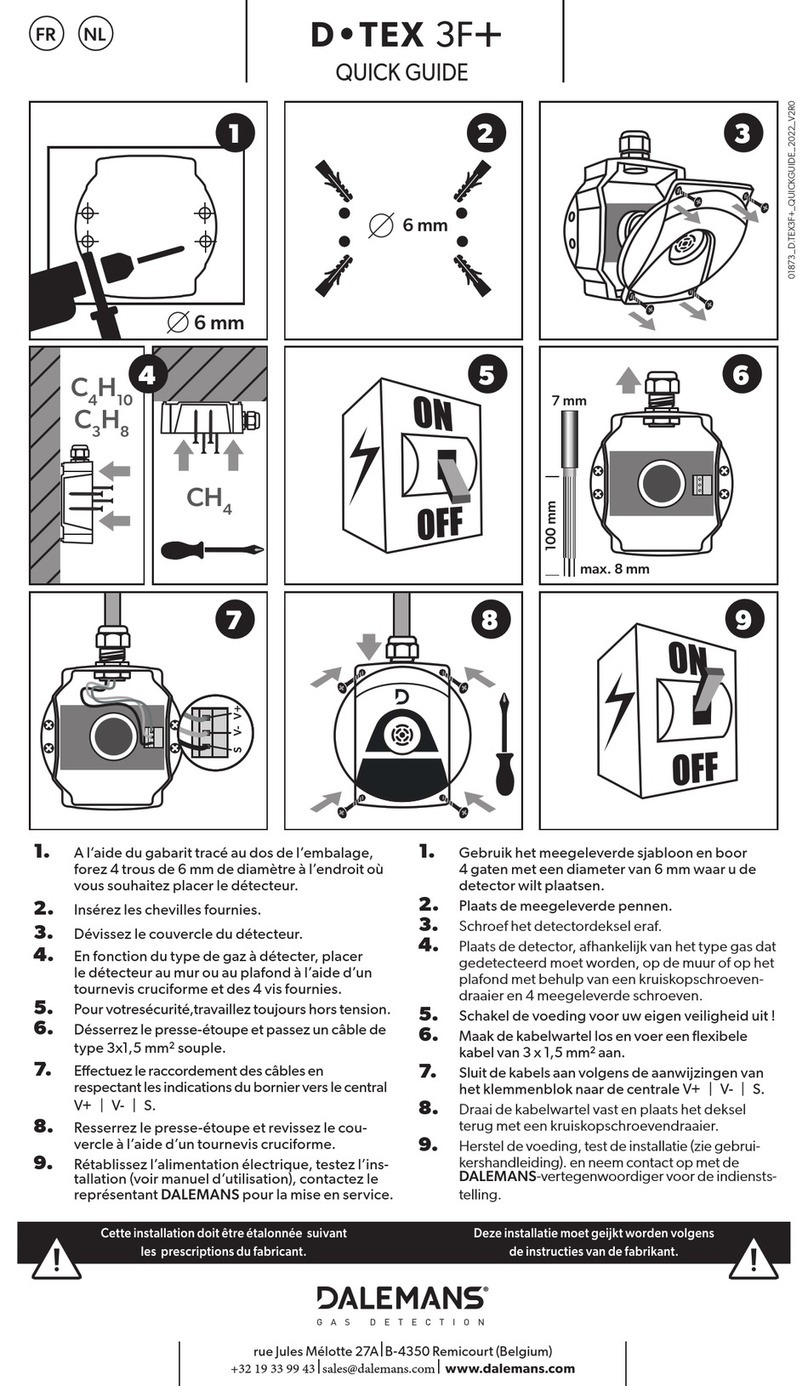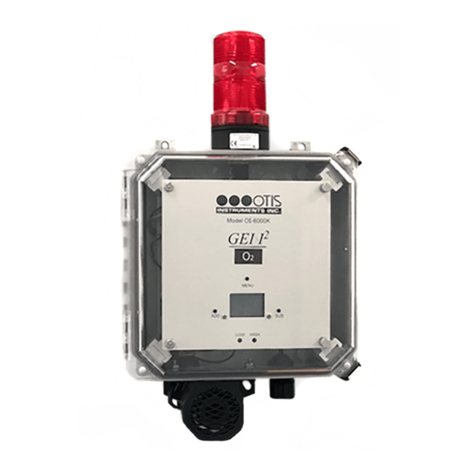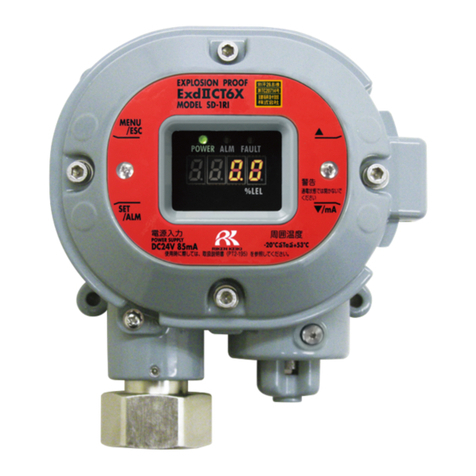Spectrex SafEye Quasar 950 Operating instructions


Legal Notice
The SPECTREX SafEye monitoring system described in this document is the property of Rosemount.
No part of the hardware, software or documentation may be reproduced, transmitted, transcribed, stored in a
retrieval system, or translated into any language or computer language, in any form or by any means, without
prior written permission of Rosemount.
While great efforts have been made to assure the accuracy and clarity of this document, Rosemount assumes no
liability resulting from any omissions in this document, or from misuse of the information obtained herein. The
information in this document has been carefully checked and is believed to be entirely reliable with all of the
necessary information included. Rosemount reserves the right to make changes to any products described herein
to improve reliability, function, or design, and reserves the right to revise this document and make changes from
time to time in content hereof with no obligation to notify any persons of revisions or changes. Rosemount does not
assume any liability arising out of the application or any use of any product or circuit described herein; neither
does it convey license under its patent rights or the rights of others.
Warranty
SPECTREX agrees to extend to Purchaser/Distributor a warranty on the SPECTREX supplied components of the
SharpEye products. SPECTREX warrants to Purchaser/Distributor that the products are free from defects in
materials and workmanship for a period of three (3) years, commencing with the date of delivery to
Purchaser/Distributor. SPECTREX expressly excludes damage incurred in transit from the factory or other damage
due to abuse, misuse, improper installation, or lack of maintenance or “Act of God” which are above and beyond its
control. SPECTREX will, upon receipt of any defective product, transportation prepaid, repair or replace it at its sole
discretion if found to have been defective when shipped. Said repair or replacement is SPECTREX’S sole liability
under this warranty and SPECTREX’S liability shall be limited to repair or replacement of the component found
defective and shall not include any liability for consequential or other damages. The customer is responsible for all
freight charges and taxes due on shipments both ways. This warranty is exclusive of all other warranties express or
implied.
TM888300 Rev. (Al), August 2019


TM888300 Rev. (Al), August 2019 v
Table of Contents
Table of Contents ............................................................................................ v
List of Figures ................................................................................................ ix
List of Tables.................................................................................................. ix
1About this Guide ...................................................................................... 11
1.1 Release History.....................................................................................12
1.2 Glossary and Abbreviations ....................................................................13
1.3 Notifications .........................................................................................14
2Product Overview .................................................................................... 15
3Technical Description .............................................................................. 17
3.1 Features ..............................................................................................17
3.2 Applications..........................................................................................18
3.3 Principles of Operation...........................................................................18
3.3.1 Definitions of Terms ........................................................................18
3.3.2 Spectral Fingerprint.........................................................................18
3.3.3 Optical Path ...................................................................................19
3.3.4 Detected Gases ..............................................................................19
3.3.5 UV Source......................................................................................20
3.3.6 Heated Optics.................................................................................20
3.3.7 HART Protocol ................................................................................20
3.3.8 Modbus RS-485 ..............................................................................20
3.3.9 Tilt Mount ......................................................................................21
3.4 Product Certification ..............................................................................21
3.4.1 ATEX, IECEx...................................................................................21
3.4.2 SIL-2.............................................................................................21
3.4.3 TR CU/EAC.....................................................................................21
3.4.4 Inmetro (UL) ..................................................................................21
3.5 Models and Types .................................................................................22
3.6 Description...........................................................................................24
3.6.1 UV Source Unit ...............................................................................25
3.6.2 Detector Unit..................................................................................25
4Operating Modes...................................................................................... 27
4.1 Operational Modes ................................................................................27
4.1.1 Normal Mode..................................................................................27

vi SafEye™ Toxic and Aromatic Open-Path Gas Detection System
4.1.2 Maintenance Call Mode (3mA Output)................................................27
4.1.3 Fault Mode .....................................................................................27
4.1.4 Zero Calibration Mode (1mA Output) .................................................28
4.2 Visual Indicators ...................................................................................28
4.3 Output Signals......................................................................................29
4.3.1 0–20mA Current Output ..................................................................29
4.3.2 RS-485 Interface ............................................................................29
4.4 System Setup.......................................................................................30
4.4.1 Detection Function Programming ......................................................30
4.4.2 Detection Setup Function .................................................................30
4.4.3 Detector Default Setup ....................................................................31
5Technical Specifications........................................................................... 33
5.1 General Specifications ...........................................................................33
5.2 Electrical Specifications..........................................................................34
5.2.1 Current Consumption ......................................................................34
5.2.2 Electrical input protection ................................................................34
5.2.3 Electrical outputs ............................................................................34
5.3 Mechanical Specifications .......................................................................35
5.4 Environmental Specifications ..................................................................35
5.4.1 High Temperature ...........................................................................36
5.4.2 Low Temperature............................................................................36
5.4.3 Humidity........................................................................................36
5.4.4 Salt and Fog...................................................................................36
5.4.5 Water and Dust ..............................................................................36
5.4.6 Shock and Vibration ........................................................................36
5.4.7 Electromagnetic Compatibility (EMC) .................................................37
6Installation Instructions.......................................................................... 39
6.1 Introduction .........................................................................................39
6.2 General Considerations ..........................................................................39
6.2.1 Personnel.......................................................................................39
6.2.2 Required Tools................................................................................39
6.2.3 Site Requirements ..........................................................................40
6.2.4 The Source and Detector .................................................................40
6.2.5 Tips for Selecting a Gas Detector Location .........................................40
6.2.6 Wiring ...........................................................................................40
6.3 Preparations for Installation ...................................................................41

TM888300 Rev. (Al), August 2019 vii
6.3.1 General .........................................................................................41
6.3.2 Equipment .....................................................................................41
6.3.3 Unpacking the Product.....................................................................41
6.4 Certification Instructions ........................................................................42
6.4.1 General Instructions........................................................................42
6.4.2 Special Conditions for Safe Use.........................................................43
6.5 Conduit/Cable Installation ......................................................................44
6.6 Detector/Source Mounting......................................................................44
6.6.1 Tilt Kit ...........................................................................................44
6.6.2 Detector/Source Installation.............................................................44
6.7 Detector Wiring ....................................................................................45
6.8 Detector Terminal Wiring .......................................................................48
6.9 UV Source Wiring ..................................................................................49
6.9.1 Wiring ...........................................................................................49
6.9.2 Terminal Wiring ..............................................................................49
7Operating Instructions ............................................................................ 51
7.1 SafEye Operation ..................................................................................51
7.2 Alignment of Unit ..................................................................................51
7.3 Powering up the System ........................................................................52
7.4 Safety Precautions ................................................................................53
7.5 Signal Verification .................................................................................53
7.5.1 Signal Values Limitation...................................................................53
7.6 Zero Calibration ....................................................................................54
7.7 Functional Check...................................................................................55
8Maintenance Instructions ........................................................................ 57
8.1 General Maintenance .............................................................................57
8.2 Periodic Maintenance .............................................................................57
8.2.1 Routine Optical Surface Cleaning ......................................................57
8.2.2 Signal Verification ...........................................................................58
8.2.3 Functional Check of Unit ..................................................................58
9Troubleshooting ...................................................................................... 59
Appendix A: Wiring Configurations ........................................................... 61
A.1 RS-485 Communication Network.............................................................63
Appendix B: Accessories ........................................................................... 65
B.1 Tilt Mount ............................................................................................65
B.2 Pole Mount (U-Bolt 2–3”) .......................................................................65

viii SafEye™ Toxic and Aromatic Open-Path Gas Detection System
B.3 Pole Mount (U-Bolt 4–5”) .......................................................................65
B.4 Wall Mount...........................................................................................65
B.5 Commissioning Kit ................................................................................65
B.6 HART Handheld Diagnostic Unit ..............................................................65
B.7 HART Handheld Harness Kit....................................................................65
B.8 USB/RS-485 Harness Converter Kit .........................................................66
B.9 Sunshade.............................................................................................66
Appendix C: SIL-2 Features ...................................................................... 67
C.1 Safety Relevant Parameters ...................................................................67
C.2 General Conditions for Safe Use..............................................................67
Technical Support ......................................................................................... 72

TM888300 Rev. (Al), August 2019 ix
List of Figures
Figure 1: System P/N Definition of Quasar 950/960...............................................23
Figure 2: P/N Definition of Quasar 950/960 ..........................................................24
Figure 3: UV Source ..........................................................................................25
Figure 4: Detector .............................................................................................26
Figure 5: Tilt Mount ...........................................................................................46
Figure 6: Detector and Tilt Mount Assembly..........................................................47
Figure 7: Detector with Cover Removed ...............................................................48
Figure 8: Source with Cover Removed .................................................................50
Figure 9: Magnetic Mode Selector........................................................................55
Figure 10: Detector Wiring Terminal ....................................................................61
Figure 11: Source Wiring Terminal ......................................................................62
Figure 12: 0–20mA Sink 4-Wire ..........................................................................62
Figure 13: 0–20mA Non-Isolated Sink 3-Wire .......................................................63
Figure 14: 0–20mA Source 3-Wire ......................................................................63
Figure 15: RS-485 Networking for Wiring Option 3 ................................................64
List of Tables
Table 1: Model Numbers and Installation Distances ...............................................22
Table 2: Detector LED Indications .......................................................................28
Table 3: Source LED Indications..........................................................................29
Table 4: Standard (default) 0–20mA Current for the Gas Channel ...........................29
Table 5: Detector Default Setup ..........................................................................31
Table 6: Source Default Setup ............................................................................31
Table 7: Detection Distance Range ......................................................................33
Table 8: Detector and Source Maximum Current Consumption ................................34
Table 9: Tools...................................................................................................39
Table 10: Tilt Mount Kit......................................................................................44
Table 11: Wiring Options....................................................................................48
Table 12: UV Source Wiring Options ....................................................................49
Table 13: Maintenance Channel Limitation Values .................................................53
Table 14: Troubleshooting ..................................................................................59


About this Guide
TM888300 Rev. (Al), August 2019 11
1About this Guide
This guide describes the Quasar 950/960 Open-Path Gas Detection System and
its features, and provides instructions on how to install, operate, and maintain
the detector.
Note:
This user guide should be read carefully by all individuals who have or
will have responsibility for using, maintaining, or servicing the
product.
This guide includes the following chapters and appendices:
•Chapter 1, About this Guide, details the layout of the guide, includes the
release history, a glossary and abbreviations, and explains how notifications
are used in the guide.
•Chapter 2, Product Overview, provides a general introduction and overview
of the product.
•Chapter 3, Technical Description, describes the detector’s theory of
operation.
•Chapter 4, Operating Modes, describes the detector’s operation modes,
user interface, and indications.
•Chapter 5, Technical Specifications, describes the detector’s electrical,
mechanical, and environmental specifications.
•Chapter 6, Installation Instructions, describes how to install the detector,
including wiring and mode settings.
•Chapter 7, Operating Instructions, describes the operating instructions
and power-up procedures.
•Chapter 8, Maintenance Instructions, describes the maintenance and
support procedures.
•Chapter 9, Troubleshooting, describes the solutions to problems that may
arise with the detector.
•Appendix A, Wiring Configurations, provides wiring diagrams for
installation.
•Appendix B, Accessories, lists accessories for the detector.
•Appendix C, SIL-2 Features, details the special conditions for compliance
with SIL-2 requirements.

About this Guide
12 SafEye™ Toxic and Aromatic Open-Path Gas Detection System
1.1 Release History
Rev
Date
Revision History
Prepared by
Approved by
0
December 2013
First Release
Ian Buchanan
Eric Zinn
1
September 2014
Second Release
Ian Buchanan
Eric Zinn
2
October 2014
Third Release
Ian Buchanan
Eric Zinn
3
November 2014
Fourth Release
Ian Buchanan
Eric Zinn
4
November 2014
Fifth Release
Ian Buchanan
Eric Zinn
5
November 2014
Sixth Release
Ian Buchanan
Eric Zinn
6
January 2015
Seventh Release
Ian Buchanan
Eric Zinn
7
March 2016
Eighth Release
Ian Buchanan
Eric Zinn
8
June 2016
Ninth Release
Ian Buchanan
Eric Zinn
9
January 2017
Tenth Release
Jay Cooley
Ian Buchanan
10
February 2017
Eleventh Release
Jay Cooley
Ian Buchanan
Ak
July 2018
Twelfth Release
Michal Heller
Udi Tzuri
Al
August 2019
Thirteenth
Release
Michal Heller
Udi Tzuri

About this Guide
TM888300 Rev. (Al), August 2019 13
1.2 Glossary and Abbreviations
Abbreviation/Term
Meaning
Analog Video
Video values are represented by a scaled signal
ATEX
Atmosphere Explosives
AWG
American Wire Gauge
BIT
Built-In-Test
CMOS
Complementary Metal-Oxide Semiconductor image
sensor
Digital Video
Each component is represented by a number
representing a discrete quantization
DSP
Digital Signal Processing
EMC
Electromagnetic Compatibility
EMI
Electromagnetic Interference
EOL
End of Line
FOV
Field of View
HART
Highway Addressable Remote Transducer –
communications protocol
IAD
Immune at Any Distance
IECEx
International Electro-Technical Commission
Explosion
IP
Internet Protocol
IPA
Isopropyl Alcohol
IR
Infrared
IR3
Refers to the 3 IR sensors in the VID
JP5
Jet Fuel
LED
Light Emitting Diode
MODBUS
Serial communications protocol using Master-Slave
messaging
N/A
Not Applicable
N.C.
Normally Closed
NFPA
National Fire Protection Association
N.O.
Normally Open
NPT
National Pipe Thread
NTSC
National Television System Committee (a color encoding
system)
PAL
Phase Alternation by Line (a color encoding
system)

About this Guide
14 SafEye™ Toxic and Aromatic Open-Path Gas Detection System
Abbreviation/Term
Meaning
P/N
Part Number
RFI
Radio Frequency Interference
RTSP
Real Time Streaming Protocol
SIL
Safety Integrity Level
UNC
Unified Coarse Thread
VAC
Volts Alternating Current
1.3 Notifications
This section explains and exemplifies the usage of warnings, cautions, and notes
throughout this guide:
Warning:
This indicates a potentially hazardous situation that could result in
serious injury and/or major damage to the equipment.
Caution:
This indicates a situation that could result in minor injury and/or
damage to the equipment.
Note:
This provides supplementary information, emphasizes a point or
procedure, or gives a tip to facilitate operation.

Product Overview
TM888300 Rev. (Al), August 2019 15
2Product Overview
The SafEye Quasar 950/960 UV Open-Path Gas Detector employs an advanced
Xenon UV Source and integrated electronics package, both of which are encased
in improved stainless steel housings, which provide high quality and performance,
fast response, and line-of-sight gas monitoring. The complete SafEye system is
backed by a 3-year warranty.
The Quasar 950/960 is manufactured only from stainless steel, with a heated
optical window to improve performance in ice, snow, and condensation
conditions. The programmable functions are available through a RS-485 or HART
port used with host software supplied by SPECTREX, and a standard PC or IS
handheld unit.
The Quasar Source and Detector unit enclosures are ATEX and IECEx approved.
They are Exd flameproof with an integral segregated rear, and an Exe terminal
compartment, which avoids exposure of the sensors and electronics to the
surrounding environment. The detector also has a plug interface for connection to
a handheld PC or HART unit, which meets intrinsically safe standards.
This manual provides a full description of the detector and its features. It includes
instructions on the installation, operation, and maintenance of the detector.
•To use the WinHost software to change the required functions, and for a
description of its maintenance, please refer to Manual TM899050 for
instructions.
•To use the HART Protocol to change the required functions, and for a
description of its maintenance, please refer to Manual TM899030. To set
functions, the HART can be connected on the 0–20mA line or through the IS
port.
The SafEye Quasar 950/960 detects and monitors toxic gases, such as ammonia,
H2S, and aromatics, ppm.m concentrations in the air. SafEye has a response
detection time of no more than 10 seconds.
The SafEye system uses an open path beam of flashlight pulses that provides a
long line of sight coverage equivalent to a large number of point detectors along
the path. The transmitted beam covers a UV spectrum from 200–300nm. The
SafEye Quasar 950/960 constantly monitors for the gas through the collimated
beam, over an optical path of up to 200ft/60m.
Warning:
The source and detector are not field-repairable due to the meticulous
alignment and calibration of the sensors and the respective circuits.
Do not attempt to modify or repair the internal circuits or change their
settings, as this will impair the system's performance and void the
SPECTREX Product warranty.


Technical Description
TM888300 Rev. (Al), August 2019 17
3Technical Description
3.1 Features
•Long-range gas detection of up to 200ft/60m
•Detection of toxic gases (H2S, NH3)
•High sensitivity and fast response to toxic gases
•Heated optics to improve performance in ice, condensation, and snow
conditions
•Continuous operation in extreme or harsh environmental conditions
•Solar blind and immune to industrial environments
•Withstands extreme vibrations
•Standard 0–20mA output
•“Maintenance Call Mode” (3mA)
•HART protocol: communications protocol
•RS-485 Output Modbus compatible with PC communications network for a
maximum of 247 systems
•Simple one-person installation, alignment, and calibration
•ATEX and IECEx approved per:
•Ex II 2(2) G D
•Ex db eb ib [ib Gb] IIB+H2 T4 Gb
•Ex tb IIIC T135°C Db
•TR CU approved per:
•1Ex db eb ib [ib Gb]IIB + H2 T4 Gb X
•Ex tb IIIC T135°C Db X
•–55°C ≤ Ta ≤ +65°C
•TUV approved per SIL2 requirements
•Inmetro (UL) approved
•Programmable configuration via the handheld unit
•Fast connection to IS-approved handheld diagnostic/calibration unit
•A 3-year warranty for the complete SafEye system

Wiring Configurations
18 SafEye™ Toxic and Aromatic Open-Path Gas Detection System
3.2 Applications
The Quasar 950/960 SafEye system can be used to monitor toxic gas
concentration in various applications, such as:
•Petrochemical, pharmaceutical, and other chemical storage and production
areas of aromatic hydrocarbons, such as benzene, toluene, xylene, etc.
•Toxic chemical storage sites and hazardous waste disposal areas
•Detection of H2S in desulfurization processes at refineries, oil platforms,
pipelines, refueling stations, and fuel storage facilities
•Transportation depots and shipping warehouses of solvents (aromatic and
polymers origin), degreasing and cleaning solvents
•Styrene monomer, polymers, and plastic industries
•Ammonia production facilities, storage, and transportation
•Air conditioning, refrigeration, and agriculture application areas for ammonia
and derivatives
•Semiconductor industry, in which ammonia concentration monitoring is
required
3.3 Principles of Operation
The Quasar system detects gases through dual-spectral range monitoring,
analyzing the absorption of radiation caused by gases in the atmosphere, and
comparing the ratio to background atmospheric absorption.
3.3.1 Definitions of Terms
The following list defines gas concentration measurement terms that are used in
this manual:
•TLV-TWA: The time average concentration for a normal 8-hour workday (40-
hour work-week) to which all workers may be repeatedly exposed, day after
day, without adverse effects.
•ppm: Concentration in parts per million. Defines the amount of gas molecule
parts per million molecules of common atmosphere gases.
•ppm.m: Integral of concentration in ppm multiplied by the distance in
meters.
3.3.2 Spectral Fingerprint
Each hazardous material is detected at a specific wavelength selected according
to its specific spectral absorption or “fingerprint.”The detection process involves
2 separate filters: one transmitting radiation that is absorbed by a particular gas,
and one that is not sensitive to it.

Technical Description
TM888300 Rev. (Al), August 2019 19
3.3.3 Optical Path
The presence of toxic airborne vapors, gases, or aerosols in a monitored area is
detected when the defined substance crosses/enters the optical path between the
radiation source unit and the detector.
Toxic gases/vapors present in the atmosphere cause absorption of the radiation
pulse at specific wavelengths in the optical path between the radiating source and
the detector unit. This causes a change in the signal intensity received by the
detector, which is translated into an output related to the detector’s measuring
scale.
The system analyzes the defined open path at the spectral bands specific to the
materials being monitored. The Automatic Gain Control (AGC) unit compensates
for environmental disturbances such as fog and rain through a constant
comparison with its dual spectral beam.
3.3.4 Detected Gases
The following toxic gases and vapors are detected by the UV SafEye models
according to their unique spectral absorption in the UV solar blind range:
•Ammonia (NH3): A flammable and toxic gas that is highly irritant, colorless,
and with a pungent odor. The lower limit of human perception is 17ppm.
Ammonia’s TLV-TWA is 25ppm.
The early detection of NH3at concentrations of up to 25ppm is essential in
order to prevent its toxic effects, such as respiratory tract paralysis. In the UV
band, NH3gas has a typically strong absorption in the solar blind range of
189–210nm that enables its fast and reliable detection at low concentrations.
•Hydrogen Sulfide (H2S): A flammable, poisonous gas with a characteristic
smell of rotten eggs. It is perceptible in air at concentrations of 0.001–
0.1ppm, with a sweetish taste, and a TLV-TWA of 10ppm.
H2S is heavier than air and very dangerous to humans, causing collapse,
coma, or death from respiratory failure within a few seconds of inhalation.
Early detection of H2S at concentrations of up to 10ppm is essential to
prevent its toxic influence.
In the UV band, H2S has a characteristically strong absorption in the solar
blind range of 189–270nm, which enables its fast and reliable detection at low
concentrations.
•Aromatic Hydrocarbons: Benzene, toluene, xylene, styrene, etc., have the
unique “conjugated double bonding” chemical configuration responsible for
their spectral absorption in the UV band. These substances, which are usually
in the liquid phase, are volatile, and their vapors are highly explosive and
toxic. Some of them have narcotic effects and/or are considered carcinogens.
Odor is perceptible in the air at 12ppm. The TLV-TWA is 10ppm.
In the UV band, the aromatic compounds have a typically strong absorption in
ranges of 200–230nm and 250–270nm, which enables fast and reliable
detection at low concentrations.

Wiring Configurations
20 SafEye™ Toxic and Aromatic Open-Path Gas Detection System
3.3.5 UV Source
The Xenon UV Source was introduced in the initial SafEye development, and was
designed to overcome false alarms, which were experienced by early generations
of the open path system. The new SafEye Quasar 950/960 employs the latest
generation of UV bulbs to provide even more power, and an extended operation
life.
3.3.6 Heated Optics
SafEye Quasar includes heated optics for the detector and source. To improve
performance in conditions where there is ice, condensation, or snow, the heater
increases the temperature of the optical surface by 5–8°F / 3–5°C above the
ambient temperature. The heated optics are configured to automatically operate
when the change in temperature requires heating (default).
However, the heated optics can be defined as one of the following modes:
•Not operated (not an option on the source unit)
•On continuously
•Automatic, per temperature change (default)
See System Setup, page 30.
When operated “per temperature change,” the user can define the start
temperature below which the window will be heated (default is 41°F/5°C). This
temperature can be defined from 32°F/0°C to 122°F/50°C. Heating stops when
the temperature is 27°F/15°C above the start temperature.
3.3.7 HART Protocol
The Quasar 950/960 uses the HART Protocol.
HART Communication is a bi-directional industrial field communication protocol
used to communicate between intelligent field instruments and host systems.
HART is the global standard for smart instrumentation, and the majority of smart
field devices installed in plants worldwide are HART-enabled.
HART technology is easy to use and very reliable.
Through the HART connection, the SafEye is able to perform:
•Detector setup
•Detector troubleshooting
•Detector health and status
For more details, refer to the HART Manual TM899030.
HART communication can be connected on the 0–20mA line, or through the IS
connection, with a standard handheld unit loaded with the host software and
attached by a special harness.
3.3.8 Modbus RS-485
For more advanced communications, the Quasar 950/960 has a RS-485 Modbus-
compatible output that provides data communication from a network (up to 247
Other manuals for SafEye Quasar 950
3
This manual suits for next models
1
Table of contents
Other Spectrex Gas Detector manuals
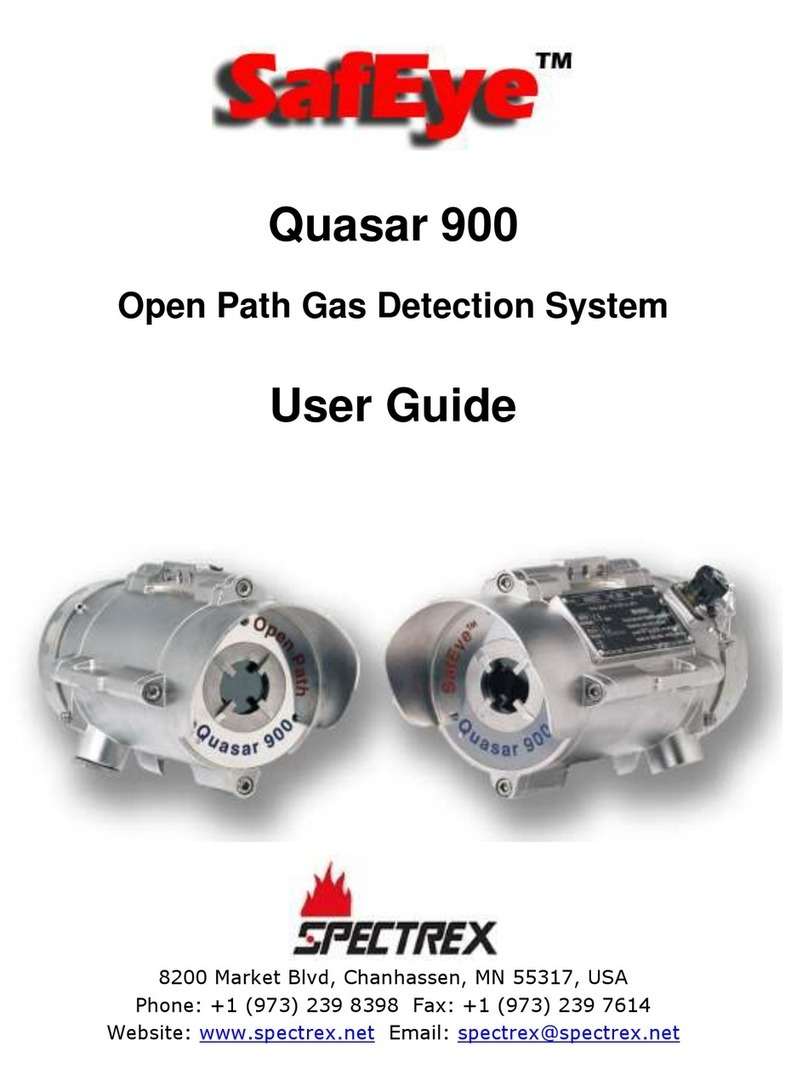
Spectrex
Spectrex SafEye Quasar 900 User manual

Spectrex
Spectrex SafEye 300 Series User manual

Spectrex
Spectrex SafEye Quasar 900 User manual
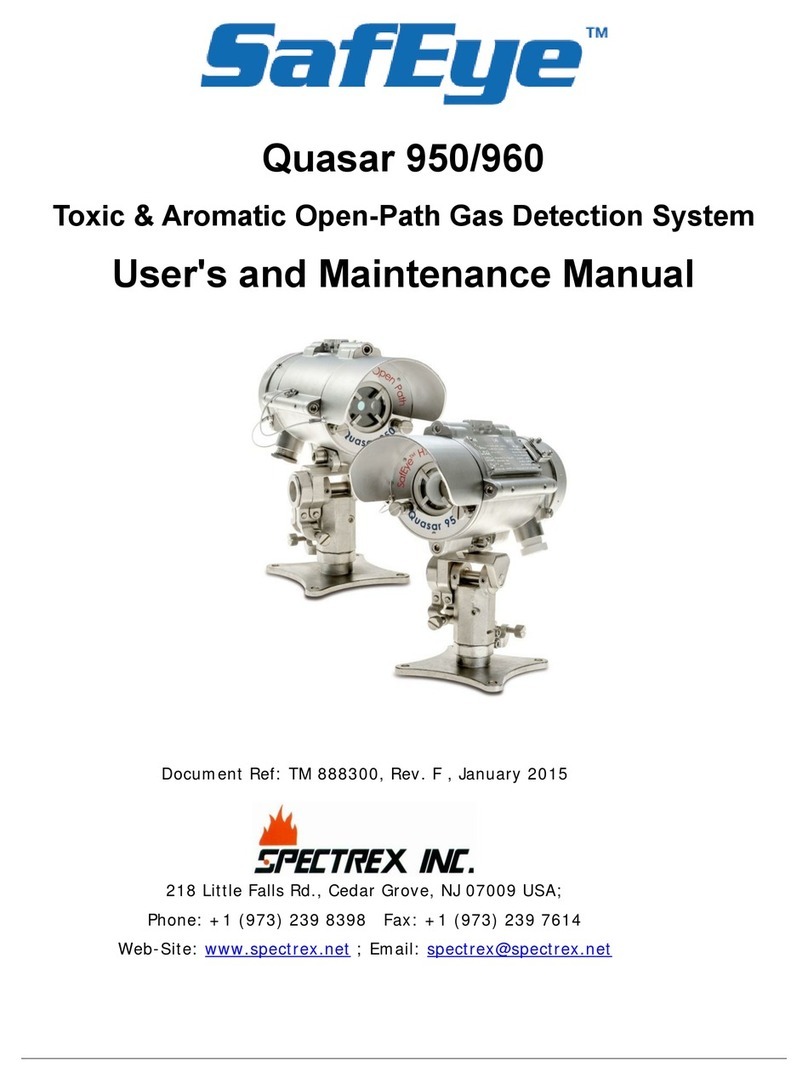
Spectrex
Spectrex SafEye Quasar 950 Operating instructions

Spectrex
Spectrex SharpEye 40U User manual

Spectrex
Spectrex SafEye Quasar 950 Configuration guide

Spectrex
Spectrex SafEye Quasar 900 User manual

Spectrex
Spectrex SafEye Quasar 950 User manual

Spectrex
Spectrex SafEye 300 Series User manual

